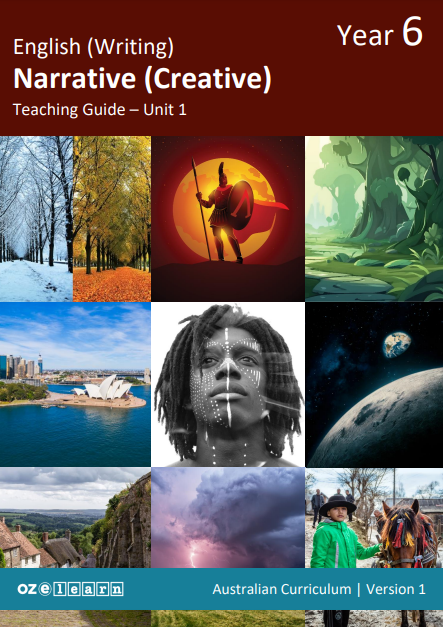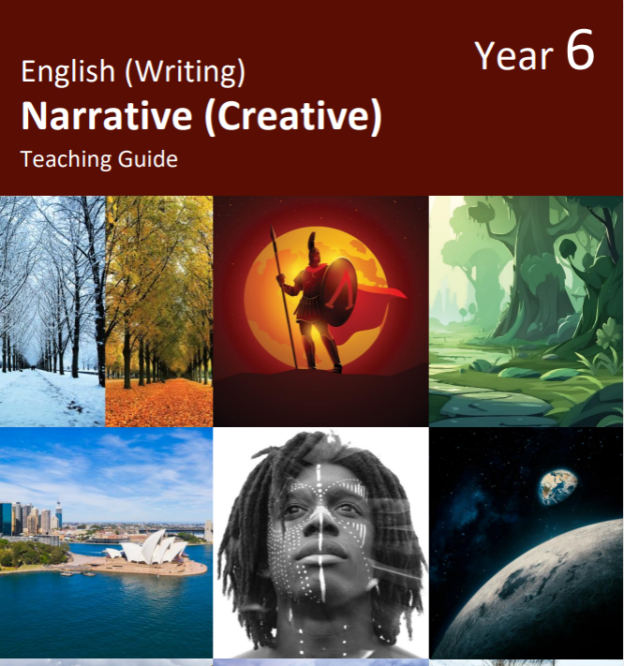Unit 1: Narrative (Creative) Year 6
Oz-e-Writing

Overview
Oz-e-Writing Year 6 Narrative (Creative) is a writing unit for Year 6 students. It aligns to the Australian Curriculum V9.0.:
- Identify authors’ use of vivid, emotive vocabulary, such as metaphors, similes, personification, idioms, imagery and hyperbole. (AC9E6LA08)
- Understand how ideas can be expanded and sharpened through careful choice of verbs, elaborated tenses and a range of adverb groups. (AC9E6LA06)
- Identify similarities and differences in literary texts on similar topics, themes or plots. (AC9E6LE02)
- Create and edit literary texts that adapt plot structure, characters, settings and/or ideas from texts students have experienced, and experiment with literary devices. (AC9E6LE05)
- Understand how embedded clauses can expand the variety of complex sentences to elaborate, extend and explain ideas. (AC9E6LA05)
- Understand how to use the comma for lists, to separate a dependent clause from an independent clause, and in dialogue. (AC9E6LA09)
- Analyse how text structures and language features work together to meet the purpose of a text, and engage and influence audiences. (AC9E6LY03)
- Plan, create, edit and publish written and multimodal texts whose purposes may be imaginative, informative and persuasive, using paragraphs, a variety of complex sentences, expanded verb groups, tense, topic-specific and vivid vocabulary, punctuation, spelling and visual features. (AC9E6LY06)
Success Criteria
- Identify the stages of an epic.
- Compare and contrast two Heroes in the first stage of an epic.
- Brainstorm the characteristics of an epic.
- Use character traits and create similes and metaphors to describe the Hero.
- Use figurative languages (simile, metaphor, personification, hyperbole, onomatopoeia and alliteration) and sensory details in writing an epic.
- Create the epic setting with figurative language.
- Compare and contrast stages of an epic.
- Use compound and complex sentences to plan the stages of an epic.
- Use one type of conflict to plan stages 4 and 5 of an epic.
- Use verb groups and modal verb groups to describe the thoughts, actions, dialogues or character traits of the epic character.
- Use sensory details to describe the Hero’s two worlds.
- Write sentences that build tension in an epic.
- Use tension different ways in writing stages 4 and 5.
- Use pacing words to help build tension in writing.
- Format dialogue correctly in writing.
- Write dialogues with different dialogue tags in writing.
- Identify character changes in reading.
- Show a character change using mental, action or speaking verbs.
- Identify adjectival phrases in reading.
- Write adjectives in the correct order in a sentence.
- Write sentences using comparative and superlative adjectives.
- Use adjectival phrases in writing an epic.
- Independently write and edit the different stages of an epic.
Learning objectives
In Lessons 1 to 40, students learn about the purpose and universal structure of an epic.
- Stage 1 – The Hero.
- Stage 2 – Need.
- Stage 3 – Go.
- Stage 4 – Search.
- Stage 5 – Find.
- Stage 6 – Take.
- Stage 7 – Return.
- Stage 8 – Change.
Teaching resources
- lessons
- Teaching Guide
- Student Workbook.
Assessment
Progress tests
Progress Tests are conducted in weeks 3, 6 and 9, allowing teachers to monitor student understanding of the concepts taught and to identify where reteaching is needed.
The Teaching Guide contains the testing questions and answers, and the Student Assessment Workbook has a section where students write their answers. Marking guides are provided in the PowerPoints, the Teaching Guide and the Student Assessment Workbook.
End-of-unit assessment
The end of unit assessment is an application of writing skills taught in the unit combined with HASS content covered throughout the unit. APPLE questions provide teachers with the opportunity to assess student understanding and drive classroom discussions.



Responses